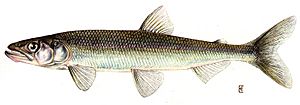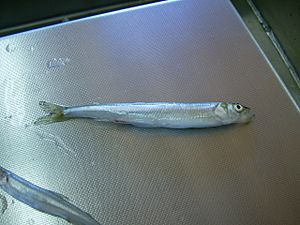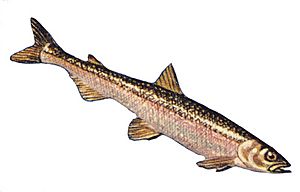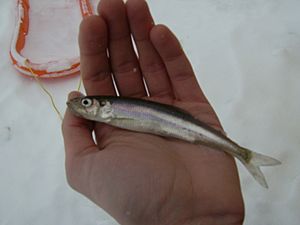Rainbow smelt facts for kids
Quick facts for kids Rainbow smelt |
|
|---|---|
 |
|
| Conservation status | |
| Scientific classification | |
| Subspecies | |
|
Osmerus mordax mordax (Mitchill, 1814) |
The rainbow smelt (Osmerus mordax) is a small fish found in North America. It belongs to the smelt family. This fish was brought to the Great Lakes and has since spread to many other areas.
Larger fish like walleye and trout often hunt and eat rainbow smelt. Smelt mostly eat young ciscoes and tiny water creatures called zooplankton. However, they are also quite aggressive and will eat almost any small fish they find.
Rainbow smelt are anadromous, which means they swim from saltwater to freshwater to lay their eggs in spring. They like clean streams with gentle water flow. These fish are not strong swimmers, so they struggle to get past most fish ladders. This makes it hard for them to reach the streams where they lay eggs. In the 1980s, more dams and soil erosion caused the smelt population to drop. But thanks to efforts to reduce human impact, their numbers are now growing again.
Contents
What Does a Rainbow Smelt Look Like?
The rainbow smelt has a thin, tube-shaped body. Its back is silvery and pale green. Its sides shimmer with purple, blue, and pink colors, and its belly is light.
When fully grown, a rainbow smelt is usually about 7 to 9 inches (18 to 23 cm) long. It weighs around 3 ounces (85 grams). Some smelt can grow even longer, over 12 inches (30 cm)!
Where Do Rainbow Smelt Live?
Rainbow smelt are found all over North America. Naturally, they live in rivers and coastal areas along the Atlantic Ocean, from New Jersey up to Labrador. They also live in Arctic waters and Pacific waters as far south as Vancouver Island.

People have introduced rainbow smelt to many lakes and rivers in the United States. For example, in 1912, smelt eggs were put into Crystal Lake in Michigan. This lake flows into Lake Michigan, and from there, the smelt quickly spread throughout the Great Lakes and their connecting rivers. They reached Lake Ontario by 1929.
Because rainbow smelt are weak swimmers, they cannot get over fish ladders. This has actually helped stop them from spreading even further into new areas.
In places where they swim between saltwater and freshwater, smelt spend their summers near the coast. They usually stay in water less than 20 feet (6 meters) deep and within 1 mile (1.6 km) of the shore. In winter, they hide under the ice in river mouths. They even make a special "antifreeze" protein to survive the cold! In spring, they lay their eggs at night in small streams, often ones that dry up in summer.
What Do Rainbow Smelt Eat?
Rainbow smelt are predators, meaning they hunt other animals for food. Studies have shown that smelt eat other fish like bloaters and alewives. If there are many smelt in a lake, they can put a lot of pressure on the food supply. One study found that a single smelt can eat a good amount of food each day.
In Lake Ontario, rainbow smelt mainly eat slimy sculpins and opossum shrimp. Some scientists believe that smelt might have caused problems for other fish. For example, they may have competed with native yellow perch for food. The U.S. EPA even thinks that smelt might have contributed to the extinction of the blue pike by outcompeting them for food.
Smelt are also sensitive to water quality. They are not found in lakes with very acidic water (pH less than 6.0). If snow melts quickly, it can make lake water more acidic, which can harm smelt eggs.
Life Cycle and Reproduction
Rainbow smelt are anadromous, meaning they travel from saltwater to freshwater to lay their eggs. However, some smelt populations live their entire lives only in freshwater.
Landlocked adult rainbow smelt lay their eggs at night in the lower parts of streams, soon after the ice melts. Female smelt lay more eggs if they are larger. Their eggs are sticky and attach to things like gravel, sand, mud, or plants underwater. The parents do not care for the eggs. The eggs hatch in 1 to 4 weeks, depending on how warm the water is.
How fast smelt grow and become ready to reproduce depends on how much food they have and the water temperature. More food and warmer water help them grow faster. In good conditions and large lakes, rainbow smelt can grow up to 14 inches (35.6 cm) long and live for more than seven years.
Fishing for Rainbow Smelt
People fish for rainbow smelt both for business and for fun. Commercial fishing for smelt is much less common now than it used to be. For example, around 1880, about 9 million smelt were caught each year from the Charles River alone. Today, very few smelt are found there.
Smelt are often used as animal feed, but people also eat them. They are a popular fish to catch in winter, especially through the ice. The "smelt run" in spring, when they swim upstream to lay eggs, is a fun tradition in many places. People also enjoy fishing for rainbow smelt with gill nets along the Chicago lakefront.
How Are Rainbow Smelt Managed?
In some areas where rainbow smelt were introduced, like the Great Lakes, their populations have been growing. People are trying different ways to manage them.
One way is through "over-fishing" or removing many fish. This helped reduce smelt numbers in some lakes in the 1980s. Some people have also tried using a chemical called Rotenone. While this works, it can also harm other living things and is not very popular.
Studies have shown that if more large predator fish, like walleye, are brought back into lakes, they can help control the smelt population naturally. This means less need for chemicals.
The rainbow smelt is considered a "Species of Concern" by the U.S. National Marine Fisheries Service. This means the U.S. government is worried about its status and threats, but they don't have enough information yet to list it under the Endangered Species Act.
See also
 In Spanish: Osmerus mordax para niños
In Spanish: Osmerus mordax para niños




